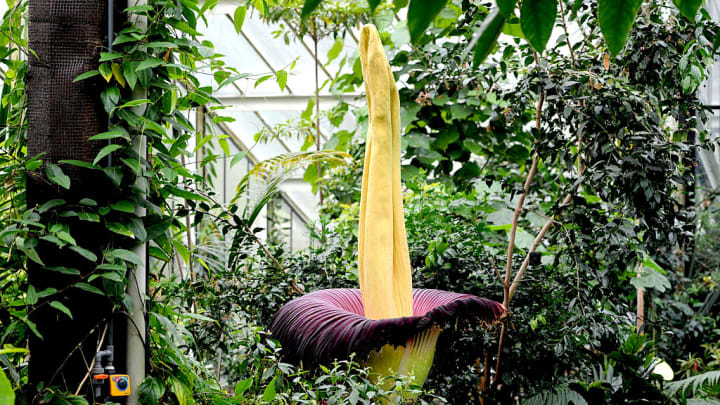
Introduction:
In the realm of exotic and bizarre plants, the Corpse Flower
(Amorphophallus titanum) reigns supreme. With its enormous size, striking
appearance, and infrequent blooming pattern, this botanical wonder has captured
the imagination of plant enthusiasts worldwide. Join us as we explore the
captivating world of the Corpse Flower and uncover the mysteries behind its
notorious reputation.
A Monstrous Marvel: The Giant Among Flowers
The Corpse Flower is aptly named for its imposing size and
distinctive odor. It boasts the title of the largest unbranched inflorescence
in the plant kingdom, with heights reaching over 10 feet (3 meters). The
flowering structure consists of a tall spadix, resembling a fleshy column,
surrounded by a petal-like spathe that opens to reveal its remarkable and often
malodorous interior.
Infrequent Bloomer: Waiting for the Rarity
One of the most intriguing aspects of the Corpse Flower is
its sporadic flowering pattern. In its natural habitat, this enigmatic plant
may only bloom once every several years or even decades. The anticipation
surrounding its bloom draws crowds of enthusiasts eager to witness the rare
spectacle. This infrequency adds to the mystique and allure of the Corpse
Flower.
The Stench of Decay: A Nauseating Attraction
The Corpse Flower's notorious reputation stems from its
pungent odor, often likened to that of rotting flesh or a decaying animal
carcass. This foul scent serves a crucial purpose in nature—it attracts carrion
beetles and flesh flies, which are the flower's primary pollinators. The
plant's odor, combined with its deep red coloration, mimics the appearance and
scent of decaying flesh, ensuring the efficient transfer of pollen from one
flower to another.
A Tropical Marvel: Origins and Habitat
Native to the rainforests of Sumatra, Indonesia, the Corpse
Flower thrives in the warm and humid conditions of its tropical habitat. It
requires specific environmental cues, including temperature fluctuations and
proper nutrition, to trigger blooming. The plant's large underground corm, a
storage organ similar to a bulb, plays a vital role in its survival during
periods of dormancy between blooming events.
Conservation Challenges and Preservation Efforts
Despite its captivating allure, the Corpse Flower faces
several conservation challenges. Habitat loss, deforestation, and illegal
collection for horticultural purposes threaten its natural populations. Various
botanical gardens and conservation organizations are actively involved in the
preservation of the species, working to raise awareness and conduct research to
better understand the plant's biology and ensure its long-term survival.
Conclusion:
The Corpse Flower stands as a botanical marvel, captivating and repelling in equal measure. Its grandeur, rarity, and infamous odor make it a source of fascination for plant enthusiasts worldwide. As we delve into the mysterious world of the Corpse Flower, we gain a deeper appreciation for the diverse adaptations and strategies plants employ for survival and reproduction. Let us continue to preserve and protect the natural habitats that nurture these extraordinary plants, ensuring that future generations can marvel at the pungent phenomenon of the Corpse Flower.

0 Comments